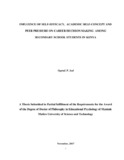INFLUENCE OF SELF-EFFICACY, ACADEMIC SELF-CONCEPT AND PEER PRESSURE ON CAREER DECISION MAKING AMONG SECONDARY SCHOOL STUDENTS IN KENYA
Abstract
Students in Kenyan secondary schools continue to face pressure on career decision making,
despite thegovernment’s emphasis on career guidance and counselingprogramme in
schools.Thousands of school-leavers miss out on suitable career choices, because of distorted
career choices. More often students make career choices in less regard to ability or talent.
Existing reportsreveal that most people are employed in areas thatare neither in line with their
professional training nor with their career interests. The purpose of this study was to examine the
influence of self-efficacy, academic self-concept and peer pressure on career decision making
among public secondary school students. Specifically, the study sought to examine the influence
of: self-efficacy, academic self-concept, peer pressure on career decision making among
secondary school students. Besides, the study sought to establish the relationship and differences
between self-efficacy, academic self-concept and peer pressure on career decision making among
secondary school students in Busia County. The study was anchored on Social Cognitive Career
and Self-concept theories by Lent, Brown and Hackett, and Donald Super respectively, and
conceptual framework. The study adopted correlational and causal comparative research designs.
The target population was 6664 form four students, 138 teachers in-charge of career guidance
and counselling and 1 County Quality Assurance and Standards Officer. The study employed
purposive sampling, stratified random sampling and simple random sampling techniques. The
sample size consisted of 393 participants (364 students, 28 teachers’ in-charge of career guidance
and counselling, and 1 County Quality Assurance and Standards Officer). Questionnaires,
interview guide and document analysis guide were used to collect data from the respondents.
Pilot study was carried out to establish the reliability and validity of the research instruments
used in data collection. Qualitative data was transcribed and reported according to themes.
Quantitative data was analyzed using descriptive statistics including frequency tables,
percentages, mean and standard deviation and inferential statistics including Spearman’s
correlation, Multinomial logistic regression and Hierarchical multiple regression. Descriptive
statistics revealed high mean and low standard deviations in variables influencing career
decisions. The results of Spearman’s correlation in objectives one to three showed statistically
significant relationship between independent variables and the outcome variable(rs 364) = -
0.236**, p=0.001)for self-efficacy,(rs (364) = -0.208, p= 0.001) for academic self-concept and(rs
(364) = 0.165, p=0.001)for peer pressure on career decision makingat α=0.05.Multinomial
logistic regression statistical models significantly compared between comparison category
relative to referent categoryhigh relative risk ratios.Hierarchical multiple regression analysis
revealed that thethree independent variableswere significant, F (1,360) =13.491, p<.05)
accounting for 11.5% of the variance in career decision making.Academic self-concept wasthe
most important predictor of career decision making accounting for 5% of the variation. It was
concluded that self- efficacy, academic self-concept and peer pressure influenced career decision
making among secondary school students in Busia County.It was recommended that career
guidance teachers in schools and the education office should aim at fostering strong and positive
self-efficacy, academic self-concept and peer relationships among students to them over
challenges faced in career decision making. It is hoped thateducation officers and career
guidance teachers will use these findings to improve on students’ skills in career decision
making.

